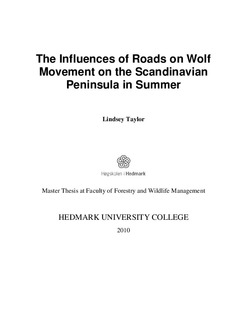The influences of roads on wolf movement on the Scandinavian peninsula in summer
Master thesis
Permanent lenke
http://hdl.handle.net/11250/132223Utgivelsesdato
2010Metadata
Vis full innførselSamlinger
Sammendrag
Over 14,000 GPS wolf positions from 15 wolves (Canis lupus) in 9 territories across the Scandinavian Peninsula were used to assess the influences of roads on wolf movement within their territories in the summer. My results show that there was a preference for wolves to travel on roads compared to off roads, and that the preference was highest for forest gravel roads (FGR) as opposed to main roads (MR). The MR density was negatively correlated with presence of wolf traveling positions, but FGR density did not influence wolf movement. Time of day also had an influence on the movement of wolves around MRs. Likelihood of a wolf being closer to a MR during night and early morning hours was higher than that at other times of day. Time of day did not strongly influence wolf travel around FGRs. The distance to a road, independent of road type, did not influence location of kill site. Wolves, in general, preferred to use roads during travel as opposed to resting. These results concur with other research saying that the wolves use the forest roads for ease of travel, hunting for prey, or territory patrolling. Many results on wolf movement in relation to roads vary by region, habitat, type of prey, and availability.
Beskrivelse
Master thesis in applied ecology, 2010
